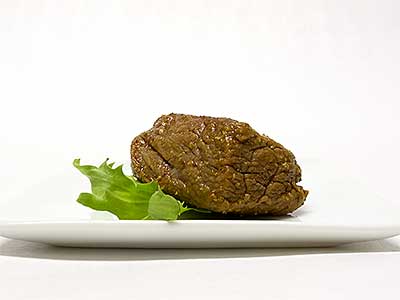November 18, 2013
Amuse-Bouche

cube de bœuf cru
(raw beef cubes)
Recipe names have been a problem for me since the days that I started cooking from cookbooks. So although the problem isn’t new, it has become exasperated by current cooking trends where a modern dish is named after the dish that inspired the new version, but the link is tenuous. I’m guilty of the practice as much as anyone. My version of modern macaroni and cheese is a far cry from my favorite traditional version.
So when I found myself watching a butchering demonstration by Dario Cecchini where he presented a preparation he called sushi del chianti, I was a little flummoxed. Maestro Cecchini is a butcher from the small, Italian town of Panzano In Chianti, located about an hour south of Florence. He has an international reputation, and in some circles is considered an ambassador of meat. The actual recipe I was handed that afternoon was labeled chianti crudo, but Maestro Cecchini seemed to prefer the sushi-alluding title. He did at one point admit that it would be more correct the call the raw slices of beef sashimi rather than sushi, but he said that name was not as marketable. Whatever the dish was called, it gave me an idea.
I have probably tasted the raw flesh of almost every whole, red-meat animal I’ve ever butchered. Although my habit tends to gross out many observers, I find that I can learn a lot about an animal by how the different muscles taste before cooking. As a society, we’ll eat raw beef if finely diced, chopped, or ground in the form of tartar or if thinly sliced in the form of carpaccio, but most people won’t eat a chunk of raw meat. A possible exception would be a piece of very rare steak, but even that is an anathema to most people.
I have also, on occasion, tasted raw beef that was marinated. That has always been interesting but the raw marinade was usually the constraining element. Marinades often contain ingredients that are better tasting when cooked. Unfortunately, I wasn’t able to taste Maestro Cecchini’s raw, marinated beef so I had to create my own. My marinade, enough to marinate four to eight cubes of beef, is as follows.
1 T
fresh Meyer lemon juice
2 t
extra-virgin olive oil
1⁄2 t
garlic powder
1⁄2 t
onion powder
1 t
ground cumin seeds
1⁄8 t
chipotle pepper powder
fine salt
1. Combine all the marinade ingredients until well-blended.
Which cut of beef to purchase is a matter of taste. (Pun intended.) The primary muscle of the tenderloin, the psoas major, is generally the most tender cut of beef, but the flavor can be bland. The muscles of the loin, the main one being the latissimus dorsi, make the tastiest steaks, but raw I prefer the meat from the inside of the rear leg. The common term for this muscle group is either top round or inside round, depending on your location in the United States or Canada. Some markets sell a cut labeled London broil that is from this same group of muscles (but not always). If you can get just the adductor portion, you’ve hit the jackpot.
For added tenderness and better marinade absorption, I attack the entire piece of meat prior to trimming with a multi-bladed tenderizer. I then cut the meat into cubes that are about 1-1⁄2 cm (5⁄8 in) in size. A good, all-day soak in the marinade is best, but I’ve soaked the beef for as little as a couple of hours. The acid in the marinade will denature the proteins giving the meat a grayish appearance. You could substitute dark soy sauce for the salt to stain the meat a tastier looking color.
When serving, I instruct my guests not to chew the meat too much. At some point all the flavor is lost, like with chewing gum, and the process becomes unpleasant. Maybe that’s why Americans don’t each cubed, raw beef?
© 2013 Peter Hertzmann. All rights reserved.
